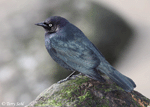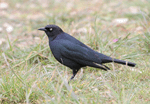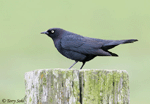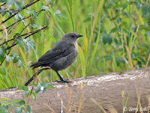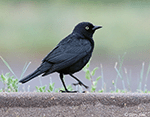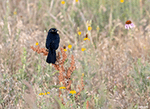| Length: 9 to 10 inches | Wingspan: 14 to 16 inches | Seasonality: Summer / Migrant |
| ID Keys: Glossy black with whitish eyes (male), shorter tail than Common Grackle | ||
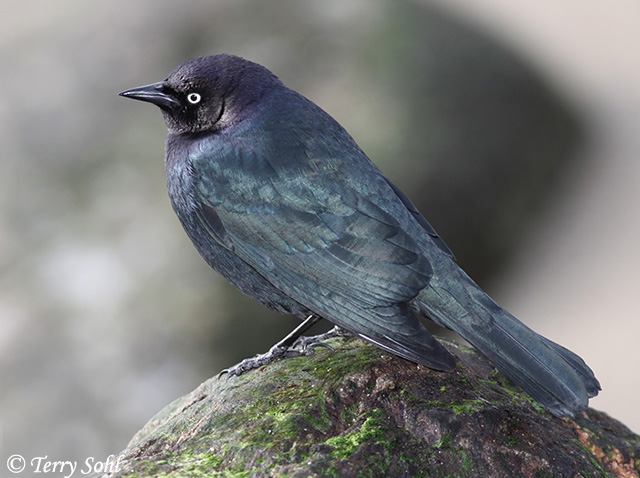 The Brewer's Blackbird is a common sight in the
open country of the western U.S., although it has also expanded its range into
the Great Lakes area. As with the Common
Grackle, they have become accustomed to a human presence, and are a common
sight in residential areas. In South Dakota, they are migrants throughout the
state, with summer breeding occurring primarily in the far western edge of the
state. However, given the proximity of the breeding range just north of South
Dakota, they can also sometimes be found as breeders in the northeastern corner
of the state.
The Brewer's Blackbird is a common sight in the
open country of the western U.S., although it has also expanded its range into
the Great Lakes area. As with the Common
Grackle, they have become accustomed to a human presence, and are a common
sight in residential areas. In South Dakota, they are migrants throughout the
state, with summer breeding occurring primarily in the far western edge of the
state. However, given the proximity of the breeding range just north of South
Dakota, they can also sometimes be found as breeders in the northeastern corner
of the state.
Brewer's Blackbirds will often form mixed blackbird flocks in migration through the state. See the "similar species" section below for other blackbird species that may be confused with the Brewer's Blackbird.
Habitat:
Can be found in a variety of open to semi-open habitats, including shrubby fields, riparian areas, farmland, shrubby grasslands, woodland edges, and even along the coastline.
Diet:
Brewer's Blackbirds feed on a wide variety of insects and spiders, as well as consuming a large amount of seeds and waste grain. Will also feed on snails and small crustaceans, and on occasion, has been known to feed on small young birds or other very small vertebrates.
Behavior:
Primarily forages by walking along the ground. Will occasionally wade in shallow water, and also will capture flying insects in mid-air. Gregarious outside of the breeding season, often forming large winter flocks.
Nesting:
June and July. Brewer's Blackbirds are typically colonial nesters, without a great deal of fidelity to colony sites from previous years. Once a handful of Brewer's Blackbirds start building nests in a territory, others often follow, filling up whatever suitable nesting site may be available. Nesting typically occurs in shrubby areas or forest edges near lake shores and rivers, but can occur in a variety of habitats. The nest of a Brewer's Blackbird is a cup, built by the female using grasses, weed stems, twigs, hair, or other available material, sometimes with mud used as a binding agent. The female lays between 3 and 6 eggs, and she alone incubates them. Incubation lasts 12 to 14 days, with young fledging from the nest 12 to 15 days after hatching.
Song:
The typical song of a Brewer's Blackbird is a short, squeaky t-seep. They also have multiple perfunctory calls, including a tchuk and a harsher, squeakier call given in alarm.
- Click here to hear the squeaky song of a Brewer's Blackbird1
- Click hear to hear a short tchuk call of a Brewer's Blackbird2
- Click here to hear a rapid alarm call of a Brewer's Blackbird3
- Click here to hear a call and squeaky song of a male Brewer's Blackbird4
Migration:
Summers throughout much of the western U.S., western Canada, and the Great Lakes area. Winters in the southern half of the U.S. and southward.
Interactive eBird Map:
Click to access an interactive eBird map of Brewer's Blackbird sightings
Similar Species:
Brewer's Blackbirds could be confused with several different "blackbird" species, including multiple species they are sometimes found in conjunction with. Here are the species most likely to be confused with a Brewer's Blackbird:
- Rusty Blackbird - Rusty Blackbirds are the most difficult bird to differentiate from a Brewer's Blackbird. In non-breeding plumage, the male Rusty Blackbird has rusty brownish tones that easily differentiate it from the Brewer's Blackbird. However, a breeding plumage Rusty Blackbird is very similar in appearance to the male Brewer's Blackbird, with a black body and pale yellow eye. Breeding plumaged Rusty Blackbirds are less glossy and more of a dull black than a breeding plumaged Brewer's Blackbird. Females of the two species are also similar in appearance. Female Rusty Blackbirds are a lighter brown than a female Brewer's Blackbird. Female Rusty Blackbirds have a pale eye while female Brewer's Blackbirds have a dark eye.
- Common Grackle - A very common bird throughout the eastern part of the Brewer's Blackbird range, although typically absent as you get closer to the west coast. Common Grackles are a larger bird than a Brewer's Blackbird, and the bill and tail are both substantially longer than those of a Brewer's Blackbird. Male Common Grackles show a glossy bluish head with some contrast with the body, while the male Brewer's Blackbird is a more subtle purple, with less contrast with the body. Females are best differentiated by the longer bill and tail of the Common Grackle. Female Common Grackles are also generally darker than female Brewer's Blackbirds.
- Brown-headed Cowbird - A common bird throughout the Brewer's Blackbird range, Brown-headed Cowbird males have a brown head that contrasts with a darker body, while the male Brewer's Blackbird is more uniform in color, with dark purplish black head. Female Brown-headed Cowbirds are brown overall, with a lighter tone than a female Brewer's Blackbird. In all plumages and sexes, the bill of a Brown-headed Cowbird is shorter and more stout than a Brewer's Blackbird.
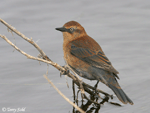 |
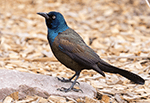 |
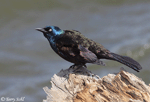 |
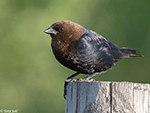 |
| Rusty Blackbird | Common Grackle | Common Grackle | Brown-headed Cowbird |
Conservation Status:
Systematic surveys in the past several decades have indicated very modest declines in overall populations. However, they are still found across a very broad geographic area, and are common in parts of that range. The IUCN considers the Brewer's Blackbird to be a species of "Least Concern".
Further Information:
Photo Information:
December 18th, 2008 - San Francisco, California - Terry Sohl
Additional Photos:
Click on the image chips or text links below for additional, higher-resolution Brewer's Blackbird photos.
Audio File Credits:
- 1Kristie Nelson. Recorded in Mono County, California on April 7th, 2015. Original recording and information available from xeno-canto.
- 2Paul Marvin. Recorded in Orange County, California on January 16th, 2017. Original recording and information available from xeno-canto.
- 3James Bradley. Recorded in British Columbia July 1st, 2016. Original recording and information available from xeno-canto.
- 4Ian Cruickshank. Recorded in Humboldt, Saskatchewan on May 6th, 2013. Original recording and information available from xeno-canto.
| Click on the map below for a higher-resolution view |
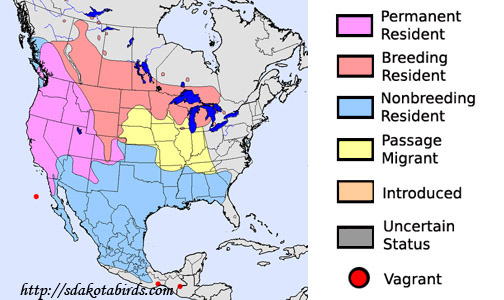 |
| South Dakota Status: Common summer resident in the far western part of the state, rare in the northeast. Locally common migrant. |
Additional Brewer's Blackbird Photos
Click for a higher-resolution version of these photos
